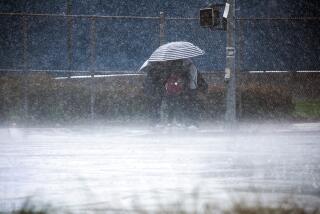EARTHQUAKE / THE LONG ROAD BACK : Counseling Aims to Ease Parents’ Minds : Schools: Staffing levels will be maintained even if enrollment drops, officials say. Students will have the same instructors--and less upheaval.
As they whittled down the list of unsafe classrooms Sunday, Los Angeles school officials showed federal visitors some rubble-strewn campuses and announced plans to ease the “terrible trauma” of the earthquake by extending counseling to parents as well as to students and staff.
In the effort to provide some stability after last week’s 6.6-magnitude temblor, the district will also abandon plans for midyear staff transfers at schools with reduced enrollment, so students will have the same instructors and less upheaval throughout the year.
Neither measure is expected to cost the beleaguered Los Angeles Unified School District much additional money in light of a massive rebuilding tab, currently estimated at $700 million.
But promises of federal help in returning school life to normal in the nation’s second-largest school district were issued Sunday by U.S. Education Secretary Richard Riley, after a tour of four quake-damaged campuses in the city.
“It’s important for a community that’s had a major disaster to get back into the daily rhythm of life as soon as possible,” Riley said during a news conference at Kennedy High School. The Granada Hills campus, near the epicenter of last Monday’s quake, is among the district’s hardest hit.
“Schoolchildren in schools is one of the most important parts of that rhythm,” Riley said, “and we’re going to do that and make sure it’s done right.”
The visit to Kennedy came after a tour of Porter and Northridge middle schools in the West San Fernando Valley, and Marvin Elementary School near the closed portion of the Santa Monica Freeway. As Riley spoke on the high school’s main quadrangle, fallen bricks and other debris from the condemned administration building lay strewn on the ground to his right. To his left, a large wall clock was stuck at 4:31--the time of the 6.6 quake last Monday.
“It is shocking to see the power of this,” said Riley, wearing sturdy leather walking shoes. “Fortunately, school was not in session.”
Teachers, administrators and support staff were scheduled to return to work today as part of a rush to clean and prepare most classrooms for the resumption of school Tuesday. As of Sunday afternoon, about 500 classrooms were still deemed unusable--a modest number, officials said, considering the district’s 30,000 classrooms at 946 sites. District officials on Saturday had put the number of unusable classrooms at 300, and said Sunday they still hope to achieve that level by Tuesday.
Sunday evening, they met with school board members to determine which schools were safe to reopen Tuesday and how much further they could reduce the number of closed campuses. They are planning to issue a definitive list of working schools today.
While students at closed schools--most of them in the hard-hit West Valley--will be staying home for now, Supt. Sid Thompson and Board President Leticia Quezada said Sunday they were encouraged by the rapid progress of the cleanup effort--from 1,500 unusable classrooms Saturday to 795 Sunday morning to 500 by Sunday afternoon. And by Tuesday, a spokeswoman said, officials hoped that number would be down to 300 classrooms districtwide.
“If the numbers continue this way, I think the picture is very good,” Quezada said.
To accommodate students whose schools will not quickly reopen and keep instruction going, Thompson said, district officials are considering morning and afternoon sessions, reopening schools already closed because of declining enrollment and altering bus routes. Transporting 33,000 students from central Los Angeles to the Valley, and 17,000 students from the city’s east to west side, will be the biggest problems, he said, because of closures at the Simi Valley and Santa Monica freeways.
To deal with longer-term academic repercussions of the quake, particularly in hard-hit areas with closed schools, the district also is considering delaying final exams and extending the school year, Thompson said.
But he said dealing with the emotional trauma of the quake and getting school life back to normal for 640,000 students will be the first priorities of educators once school buildings are declared safe and operational. Counselors will be available to students and staff on campus, and hot lines opened for parents, especially those afraid to send their children back to class.
“If we don’t do that kind of training for parents, it’s very likely many kids will not return to school,” Quezada said.
Beginning today, clinical social workers and senior psychologists will be available by telephone. Some concerns may be handled over the phone, while other cases may require an office visit for group or individual counseling, according to a district announcement Sunday.
Marleen Wong, director of the district’s School Mental Health Services unit, said that returning young people to familiar routines such as school is one of the most helpful steps in recovering from a trauma like an earthquake. But she cautioned that fears about being separated from the family may still occur.
Pledging whatever additional funding may be necessary to bring normality back to campuses, Riley said, “I’m told that when a young person is accustomed to having their school open it’s part of the family structure. When it’s not, it’s very difficult for them to deal with and we’re going to see to it that the proper counseling is there.”
Quezada said the district also has decided to abandon its usual adjustment of school staffing at the end of January--transferring teachers and other employees from schools with dropped enrollments--to maintain continuity for traumatized students.
“This is usually a cause of great turmoil and instability and we don’t want to have that now.”
A spokeswoman for Riley said later that the federal government will not pay the salaries of existing school counselors, but will reimburse expenses such as overtime and additional staff if such costs are incurred because of the earthquake.
The school district has yet to estimate the cost of such disaster-related operational expenses--apart from rebuilding costs to be covered by FEMA, said spokeswoman Camille Johnston. So far, the U.S. Education Department has committed $10 million, and a bill seeking additional funding is expected to be heard in Congress this week, she said.
FEMA Director James L. Witt, who accompanied Riley on his school tour Sunday, reiterated promises of speedy funding for rebuilding. He said teams of state and federal building inspectors will start writing reports on the school damage so they can be filed and the funding process begun immediately.
FEMA can also send portable classrooms within 10 days if they are necessary, Witt said.
“I don’t think a lot of people realize the magnitude of this disaster,” Witt said at the news conference. “This is a very large disaster and it’s taking a tremendous amount of people and assets to respond to it.”
More to Read
Sign up for Essential California
The most important California stories and recommendations in your inbox every morning.
You may occasionally receive promotional content from the Los Angeles Times.











